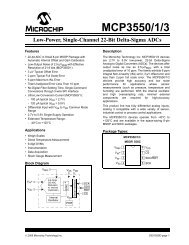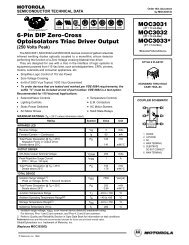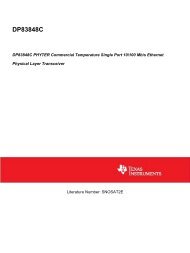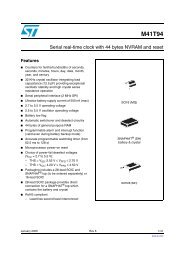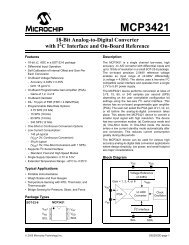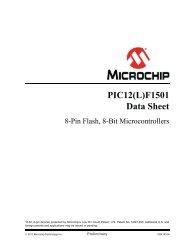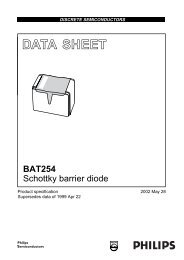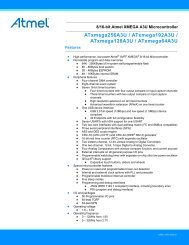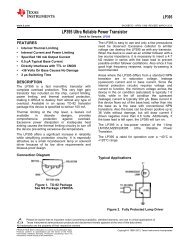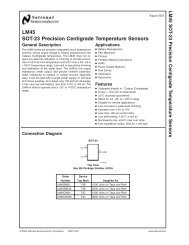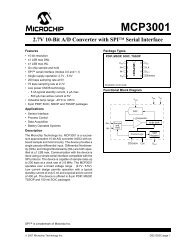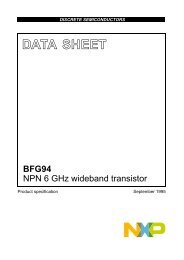- Page 2 and 3:
Note the following details of the c
- Page 4 and 5:
PIC24FJ128GA010 FAMILYDS39747E-page
- Page 6 and 7:
PIC24FJ128GA010 FAMILYDS39747E-page
- Page 8 and 9:
PIC24FJ128GA010 FAMILYTO OUR VALUED
- Page 10 and 11:
PIC24FJ128GA010 FAMILY1.1.4 EASY MI
- Page 12 and 13: PIC24FJ128GA010 FAMILYFIGURE 1-1:PI
- Page 14 and 15: PIC24FJ128GA010 FAMILYTABLE 1-2:Fun
- Page 16: PIC24FJ128GA010 FAMILYTABLE 1-2:Fun
- Page 20 and 21: PIC24FJ128GA010 FAMILYNOTES:DS39747
- Page 22 and 23: PIC24FJ128GA010 FAMILYFIGURE 2-1:PI
- Page 24 and 25: PIC24FJ128GA010 FAMILY2.2 CPU Contr
- Page 26 and 27: PIC24FJ128GA010 FAMILY2.3 Arithmeti
- Page 28 and 29: PIC24FJ128GA010 FAMILY3.1.1 PROGRAM
- Page 30 and 31: PIC24FJ128GA010 FAMILY3.2.2 DATA ME
- Page 32 and 33: DS39747E-page 32 © 2009 Microchip
- Page 34 and 35: DS39747E-page 34 © 2009 Microchip
- Page 36 and 37: DS39747E-page 36 © 2009 Microchip
- Page 38 and 39: DS39747E-page 38 © 2009 Microchip
- Page 40 and 41: DS39747E-page 40 © 2009 Microchip
- Page 42 and 43: PIC24FJ128GA010 FAMILY3.2.5 SOFTWAR
- Page 44 and 45: PIC24FJ128GA010 FAMILY3.3.2 DATA AC
- Page 46 and 47: PIC24FJ128GA010 FAMILYNOTES:DS39747
- Page 48 and 49: PIC24FJ128GA010 FAMILY4.2 RTSP Oper
- Page 50 and 51: PIC24FJ128GA010 FAMILY4.6.1 PROGRAM
- Page 52 and 53: PIC24FJ128GA010 FAMILY4.6.2 PROGRAM
- Page 54 and 55: PIC24FJ128GA010 FAMILYREGISTER 5-1:
- Page 56 and 57: PIC24FJ128GA010 FAMILYTABLE 5-3:RES
- Page 58 and 59: PIC24FJ128GA010 FAMILYNOTES:DS39747
- Page 60 and 61: PIC24FJ128GA010 FAMILYFIGURE 6-1:PI
- Page 64 and 65: PIC24FJ128GA010 FAMILYREGISTER 6-3:
- Page 66 and 67: PIC24FJ128GA010 FAMILYREGISTER 6-5:
- Page 68 and 69: PIC24FJ128GA010 FAMILYREGISTER 6-7:
- Page 70 and 71: PIC24FJ128GA010 FAMILYREGISTER 6-9:
- Page 72 and 73: PIC24FJ128GA010 FAMILYREGISTER 6-11
- Page 74 and 75: PIC24FJ128GA010 FAMILYREGISTER 6-13
- Page 76 and 77: PIC24FJ128GA010 FAMILYREGISTER 6-15
- Page 78 and 79: PIC24FJ128GA010 FAMILYREGISTER 6-17
- Page 80 and 81: PIC24FJ128GA010 FAMILYREGISTER 6-19
- Page 82 and 83: PIC24FJ128GA010 FAMILYREGISTER 6-21
- Page 84 and 85: PIC24FJ128GA010 FAMILYREGISTER 6-23
- Page 86 and 87: PIC24FJ128GA010 FAMILYREGISTER 6-25
- Page 88 and 89: PIC24FJ128GA010 FAMILYREGISTER 6-28
- Page 90 and 91: PIC24FJ128GA010 FAMILYREGISTER 6-30
- Page 92 and 93: PIC24FJ128GA010 FAMILYNOTES:DS39747
- Page 94 and 95: PIC24FJ128GA010 FAMILY7.1 CPU Clock
- Page 96 and 97: PIC24FJ128GA010 FAMILYREGISTER 7-1:
- Page 98 and 99: PIC24FJ128GA010 FAMILYREGISTER 7-3:
- Page 100 and 101: PIC24FJ128GA010 FAMILYA recommended
- Page 102 and 103: PIC24FJ128GA010 FAMILY8.2.2 IDLE MO
- Page 104 and 105: PIC24FJ128GA010 FAMILY9.1.1 OPEN-DR
- Page 106 and 107: PIC24FJ128GA010 FAMILYREGISTER 10-1
- Page 108 and 109: PIC24FJ128GA010 FAMILYFIGURE 11-1:T
- Page 110 and 111: PIC24FJ128GA010 FAMILYREGISTER 11-1
- Page 112 and 113:
PIC24FJ128GA010 FAMILYNOTES:DS39747
- Page 114 and 115:
PIC24FJ128GA010 FAMILY12.1 Input Ca
- Page 116 and 117:
PIC24FJ128GA010 FAMILYTo generate a
- Page 118 and 119:
PIC24FJ128GA010 FAMILYEXAMPLE 13-1:
- Page 120 and 121:
PIC24FJ128GA010 FAMILYNOTES:DS39747
- Page 122 and 123:
PIC24FJ128GA010 FAMILYTo set up the
- Page 124 and 125:
PIC24FJ128GA010 FAMILYREGISTER 14-1
- Page 126 and 127:
PIC24FJ128GA010 FAMILYREGISTER 14-2
- Page 128 and 129:
PIC24FJ128GA010 FAMILYFIGURE 14-3:S
- Page 130 and 131:
PIC24FJ128GA010 FAMILYEQUATION 14-1
- Page 132 and 133:
PIC24FJ128GA010 FAMILYFIGURE 15-1:I
- Page 134 and 135:
PIC24FJ128GA010 FAMILYREGISTER 15-1
- Page 136 and 137:
PIC24FJ128GA010 FAMILYREGISTER 15-2
- Page 138 and 139:
PIC24FJ128GA010 FAMILYREGISTER 15-3
- Page 140 and 141:
PIC24FJ128GA010 FAMILY16.1 UART Bau
- Page 142 and 143:
PIC24FJ128GA010 FAMILYREGISTER 16-1
- Page 144 and 145:
PIC24FJ128GA010 FAMILYREGISTER 16-2
- Page 146 and 147:
PIC24FJ128GA010 FAMILYNOTES:DS39747
- Page 148 and 149:
PIC24FJ128GA010 FAMILYREGISTER 17-1
- Page 150 and 151:
PIC24FJ128GA010 FAMILYREGISTER 17-2
- Page 152 and 153:
PIC24FJ128GA010 FAMILYREGISTER 17-5
- Page 154 and 155:
PIC24FJ128GA010 FAMILYFIGURE 17-2:
- Page 156 and 157:
PIC24FJ128GA010 FAMILYFIGURE 17-9:E
- Page 158 and 159:
PIC24FJ128GA010 FAMILY18.1 RTCC Mod
- Page 160 and 161:
PIC24FJ128GA010 FAMILYREGISTER 18-1
- Page 162 and 163:
PIC24FJ128GA010 FAMILY18.1.4 RTCVAL
- Page 164 and 165:
PIC24FJ128GA010 FAMILY18.1.5 ALRMVA
- Page 166 and 167:
PIC24FJ128GA010 FAMILY18.2 Calibrat
- Page 168 and 169:
PIC24FJ128GA010 FAMILYNOTES:DS39747
- Page 170 and 171:
PIC24FJ128GA010 FAMILYFIGURE 19-2:
- Page 172 and 173:
PIC24FJ128GA010 FAMILYNOTES:DS39747
- Page 174 and 175:
PIC24FJ128GA010 FAMILYFigure 20-1:1
- Page 176 and 177:
PIC24FJ128GA010 FAMILYREGISTER 20-2
- Page 178 and 179:
PIC24FJ128GA010 FAMILYREGISTER 20-4
- Page 180 and 181:
PIC24FJ128GA010 FAMILYEQUATION 20-1
- Page 182 and 183:
PIC24FJ128GA010 FAMILYNOTES:DS39747
- Page 184 and 185:
PIC24FJ128GA010 FAMILYREGISTER 21-1
- Page 186 and 187:
PIC24FJ128GA010 FAMILYNOTES:DS39747
- Page 188 and 189:
PIC24FJ128GA010 FAMILYREGISTER 22-1
- Page 190 and 191:
PIC24FJ128GA010 FAMILYREGISTER 23-1
- Page 192 and 193:
PIC24FJ128GA010 FAMILYREGISTER 23-2
- Page 194 and 195:
PIC24FJ128GA010 FAMILYREGISTER 23-4
- Page 196 and 197:
PIC24FJ128GA010 FAMILY23.3 Watchdog
- Page 198 and 199:
PIC24FJ128GA010 FAMILYNOTES:DS39747
- Page 200 and 201:
PIC24FJ128GA010 FAMILYTABLE 24-1:Fi
- Page 202 and 203:
PIC24FJ128GA010 FAMILYTABLE 24-2:IN
- Page 204 and 205:
PIC24FJ128GA010 FAMILYTABLE 24-2:As
- Page 206 and 207:
PIC24FJ128GA010 FAMILYNOTES:DS39747
- Page 208 and 209:
PIC24FJ128GA010 FAMILY25.2 MPLAB C
- Page 210 and 211:
PIC24FJ128GA010 FAMILY25.11 PICkit
- Page 212 and 213:
PIC24FJ128GA010 FAMILY26.1 DC Chara
- Page 214 and 215:
PIC24FJ128GA010 FAMILYTABLE 26-6:DC
- Page 216 and 217:
PIC24FJ128GA010 FAMILYTABLE 26-8:DC
- Page 218 and 219:
PIC24FJ128GA010 FAMILYTABLE 26-11:I
- Page 220 and 221:
PIC24FJ128GA010 FAMILYFIGURE 26-3:E
- Page 222 and 223:
PIC24FJ128GA010 FAMILYFIGURE 26-4:C
- Page 224 and 225:
PIC24FJ128GA010 FAMILYTABLE 26-20:
- Page 226 and 227:
PIC24FJ128GA010 FAMILY27.2 Package
- Page 228 and 229:
PIC24FJ128GA010 FAMILY100-Lead Plas
- Page 230 and 231:
PIC24FJ128GA010 FAMILYNOTES:DS39747
- Page 232 and 233:
PIC24FJ128GA010 FAMILYNOTES:DS39747
- Page 234 and 235:
PIC24FJ128GA010 FAMILYEElectrical C
- Page 236 and 237:
PIC24FJ128GA010 FAMILYSSelective Pe
- Page 238 and 239:
PIC24FJ128GA010 FAMILYREADER RESPON
- Page 240:
WORLDWIDE SALES AND SERVICEAMERICAS



